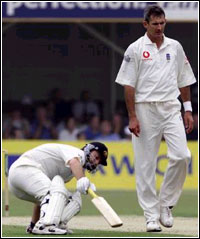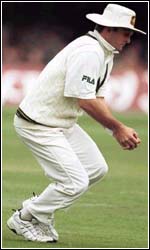Dropped catches lose matches!
Daniel Laidlaw
As a wise person once said, catches win matches. As a wiser person once
countered, catches don't win matches, dropped catches lose them. England
proved the truth of the second, more accurate maxim in the loss to Australia
in the second Test at Lord's that all but guaranteed the Ashes are out of
English reach for at least another two years.
Before the series and after the first Test, England's players were quick to
publicly note that in order to compete with Australia, they had to take
every opportunity. It would far from guarantee them even one victory, but to
simply compete on level terms with a superior opponent, chances of all forms
had to be seized. There is no more recognisable missed opportunity than a
dropped catch, which was England's chief downfall in the second Test.
 Through the first two Tests, English scores of 294, 164, 187 and 227 were
not unexpected. Disappointing, certainly, but not surprising given the
potency of Australia's attack. Since its batsmen could only be expected to
manage competitive rather than dominating scores, the key to England's
chances was bowling. For them, it had to be a bowlers' series. Thus the
greatest disappointment for England in the series to date has been
Australia's two match-winning totals, 576 and 401, and how they were
achieved.
Through the first two Tests, English scores of 294, 164, 187 and 227 were
not unexpected. Disappointing, certainly, but not surprising given the
potency of Australia's attack. Since its batsmen could only be expected to
manage competitive rather than dominating scores, the key to England's
chances was bowling. For them, it had to be a bowlers' series. Thus the
greatest disappointment for England in the series to date has been
Australia's two match-winning totals, 576 and 401, and how they were
achieved.
Though fast scoring and spectacularly dominant when playing well,
Australia's style of batting is inherently risky. Its weakness in the recent
past has been inconsistency, landslide one-session collapses, and an
underperforming top order. Though the last flaw remains true, England gave
itself no chance of realising the first two deficiencies through sometimes
wayward, often misguided and, in the second Test, under-strength bowling,
but more calamitously a spate of dropped catches.
The second Test was a more comprehensive Australian victory than the first.
Don't let the comparative margins of victory fool you. Perhaps when
Australia was 27/2 in the first innings England were better positioned than
at any stage in Edgbaston, but overall their competitive moments were fewer.
Some may ask what might have happened had England set any kind of defendable
total, given that Australia lost two wickets in reaching an academic target
of 14. Realistically, it was a momentary loss of focus after victory had
already been assured, though Darren Gough's dismissal of Ricky Ponting was a
valuable psychological blow. With the second innings failure, Ponting will
harbour more doubts than he otherwise would have after his first two innings
in the series had been terminated by virtually unplayable deliveries. That,
at least, is something Gough and co. can work in the third Test.
In the first two Tests, the Waughs have provided the pivotal partnerships of
the Australian innings', which is both a concern for the tourists and minor
source of comfort for England. Australia's two most experienced batsman have
been forced not exactly to rescue their team, since it has never appeared in
an undue amount of danger, but to establish the heart of the innings after
it had been faltering somewhat. That is essentially the situation England
would have wanted, but failed to build upon.
When Caddick had Slater caught behind on day two at Lord's, Australia were 105/3 and still 82 behind England's total, a position the Australians, if
they were bowling, might have turned into a first innings deficit of less
than 50. England ruined any chance of doing that through its misguided
strategy to Mark Waugh and the lack of adequate support bowling for Gough
and Caddick. Of the 12 Australian wickets to fall in the second Test, Gough
and Caddick claimed 10, which says enough in itself. Yes, McGrath and
Gillespie claimed 15 of England's 20 wickets, but they had powerful backup
in Warne and Lee, whose two wickets were important ones taken at the right
moments.
Craig White's figures of 0/80 from 18 overs, contributing 0 and 27 not out
with the bat, is not enough to justify his selection. His bowling, which has
to be the main reason he is picked, is not the style that troubles
Australia. His stock ball slides in to the right-handers, which is not the
angle of delivery to concern most Australian batsmen. Playing as a genuine
bowler, Dominic Cork also was not threatening enough, either in pace or
movement of the ball. He and White were not trusted by Atherton to bowl
together, meaning one of Gough or Caddick had to be in the attack at all
times and were thus overworked. Whether it be Chris Silverwood or someone
else, England needs another quick bowler or two who can be accurate over a
spell and at least build up pressure from one end.
After the Waughs had been dislodged to bring Australia back to 230/5,
England was confronted by the middle order that was so destructive in the
first Test, which is what made the dropped catches so agonising. Adam
Gilchrist is singularly the wrong type of batsman to reprieve due to his
explosiveness. For the record, Gilchrist was put down on 13, 32, 49 and 72
in his score of 90.
Australia's tail-order batting is not as strong as it is reputed to be, so if
Gilchrist had been taken at second slip by Butcher first ball of the second
over on day three, after the tourists resumed at 255/5, the match would
certainly have been more competitive. That could have been termed the
defining moment, if the mistake had not been repeated three more times.
Damien Martyn was unfortunate to be dismissed when he was, swaying away from
what should have been a Caddick bouncer with the second new ball that failed
to climb and deflected off the edge of his bat, for he was arguably in
better form than Mark Waugh. His timing was consummate and the surety of his
defensive strokes reminiscent of the best of VVS Laxman. The Caddick
breakthrough was followed in the next over by the second miss of Gilchrist,
which to be fair on Ian Ward at point was hit hard and forced him to lunge
to his left.
 Unfortunately for Ward, when either Hussain or Vaughan return it should be
he, rather than Butcher or Ramprakash, who makes way. Under the examination
of McGrath, Ward's back foot defence has been found wanting and the way he
has left a gap between bat and body has made him both susceptible to catches
in slips and being bowled off the inside edge.
Unfortunately for Ward, when either Hussain or Vaughan return it should be
he, rather than Butcher or Ramprakash, who makes way. Under the examination
of McGrath, Ward's back foot defence has been found wanting and the way he
has left a gap between bat and body has made him both susceptible to catches
in slips and being bowled off the inside edge.
Butcher's second dropped catch at gully was excusable for similar reasons to
Ward's but the mistake at slip by Atherton, for whom one can't help but feel
some sympathy, and the overall total of four missed chances off one batsman
can only be interpreted as bad cricket.
The last day action was familiar to anyone who has seen Australia demolish
its opponents in recent times. Some might say it demonstrates England's
batting is still as precarious as a house of cards, but how much blame can
they really assume? Australia has consistently captured a rapid succession
of wickets against every side it has defeated. It's how they win Tests.
Whether batting or bowling, their method is to dominate the key moments by
striking quickly, almost before the opposition knows and can react to what
has hit them.
They have had so much success doing it that they are easily and confidently
able to ride through the opposition's better periods, knowing it is a matter
of time before momentum swings back in their favour. After a hostile Lee had
struck to remove Graham Thorpe for 2 and reduce England to 50/3 at tea on
day three, England enjoyed its best period of play in the series to date in
the batting of pre-series rejects Butcher and Ramprakash.
Ramprakash overcame his hesitation to play Warne comfortably (even batsmen
with surnames of Indian origin can play Warne with ease, apparently) and
Butcher did what he had promised to do in his previous three innings by
passing fifty with assurance. Unlike several of his colleagues, Butcher has
appeared defensively secure and committed to his attacking shots, let down
only by temperament.
Gillespie, rated by Steve Waugh as being in the same class as McGrath and
apparently impressing English observers as much as he has everyone else who
has seen him bowl, snapped the partnership when Ramprakash fatally played
back, but the positive session meant England carried hope of more resistance
on the fourth day.
 Instead, they were crushed in an hour, closing to within 26 runs of making
Australia bat again before McGrath, seemingly always at the forefront when
the match is to be won, struck with two wickets in two balls in his first
over of the day. The fractionally extra seam movement in England has made
McGrath even more effective than normal and his delivery to Stewart, who
erroneously played back, was another example of the one that seams back
sharply to the right-hander.
Instead, they were crushed in an hour, closing to within 26 runs of making
Australia bat again before McGrath, seemingly always at the forefront when
the match is to be won, struck with two wickets in two balls in his first
over of the day. The fractionally extra seam movement in England has made
McGrath even more effective than normal and his delivery to Stewart, who
erroneously played back, was another example of the one that seams back
sharply to the right-hander.
McGrath was deservedly named man of the match for doing what he does best,
striking in the first innings when the match is always in the balance.
Others have more pace and explosive deliveries but currently none match
McGrath for rhythm and unrelenting testing of a batsman's judgement,
economically placing the ball on the spot where he is most likely to get the
batsman out.
Gillespie finished the job to collect his first five-for at Lord's and, as
Australia's bowlers have decided to do now, acknowledged the feat by holding
up the ball to the crowd as a batsman does after his hundred. Appropriately,
England's innings ended with a feature catch, Mark Waugh snaring Gough to
give Gillespie his fifth wicket and break the Test catching record. That
feat, and particularly Ponting's earlier two-handed overhead grab springing
to his right to dismiss Ward and start the slide, highlighted the catching
disparity that was the most notable difference between Australia and England
in the second Test.
More Columns
Mail Daniel Laidlaw